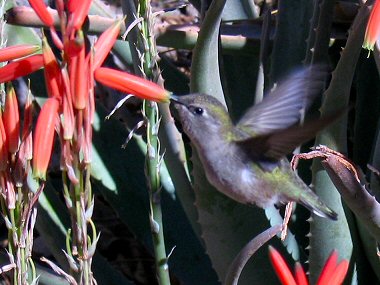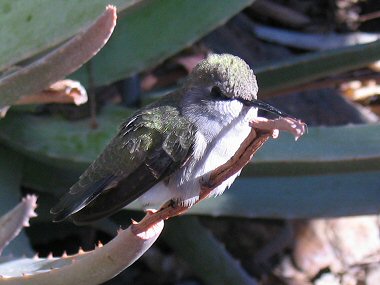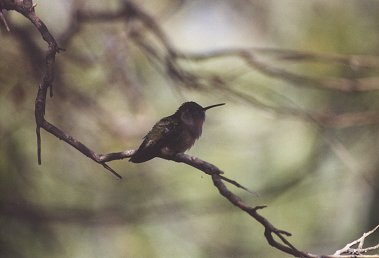 There are over
a dozen species of
hummingbirds that live in Arizona at least part of
the year; they include the Broad-billed, Black-chinned, Anna's, Costa's
& Rufous humming bird. They
range in size from 2
½
to 5 inches in length, and from 2 to 10 grams in weight. The males are
the most colorful and may have bright throat and head patches (probably
to attract females). There are over
a dozen species of
hummingbirds that live in Arizona at least part of
the year; they include the Broad-billed, Black-chinned, Anna's, Costa's
& Rufous humming bird. They
range in size from 2
½
to 5 inches in length, and from 2 to 10 grams in weight. The males are
the most colorful and may have bright throat and head patches (probably
to attract females).
|
Why does the hummingbird hum?
Because it's beating its wings more than 80 times each second! |
In the Sonoran Desert, hummingbirds can be found in
desert, grassland, woodland and forest, though they tend to prefer the
scrubbier open areas. They primarily feed on nectar (or sugar water if
you have a feeder like I do), but also will eat small insects.
Hummingbirds are extremely territorial and protect their food and nests
vigorously by chasing off any other hummers that come near. Females do
all the work when it comes to chicks. She will build the nest, incubate
the eggs and tend to the young until they are old enough to survive on
their own. The best time to see hummers in Arizona is in late summer,
when several species are traveling through the region on their way
south. Here are a few interesting Hummingbird
facts:
-
 Hummingbirds
have hearts that are larger
in proportion to body size than those of any other warm-blooded
animal. Hummingbirds
have hearts that are larger
in proportion to body size than those of any other warm-blooded
animal.
- Hummers have the most rapid heart rate for a
bird - up to 500 beats per minute at rest and 1260 bpm during
activity.
- Their flight muscles account for 25-30% of
their body weight (in other birds it is typically 15-25%).
- They can dive at over 60 miles per hour.
- They have high body temperatures - 105 to 109
degrees Fahrenheit.
- Hummingbirds may consume 70% of their body
weight in solid food per day and 4-8 times their body weight in
water.
- You can make your own hummingbird nectar by
mixing 4 parts water to 1 part sugar.

|
|

